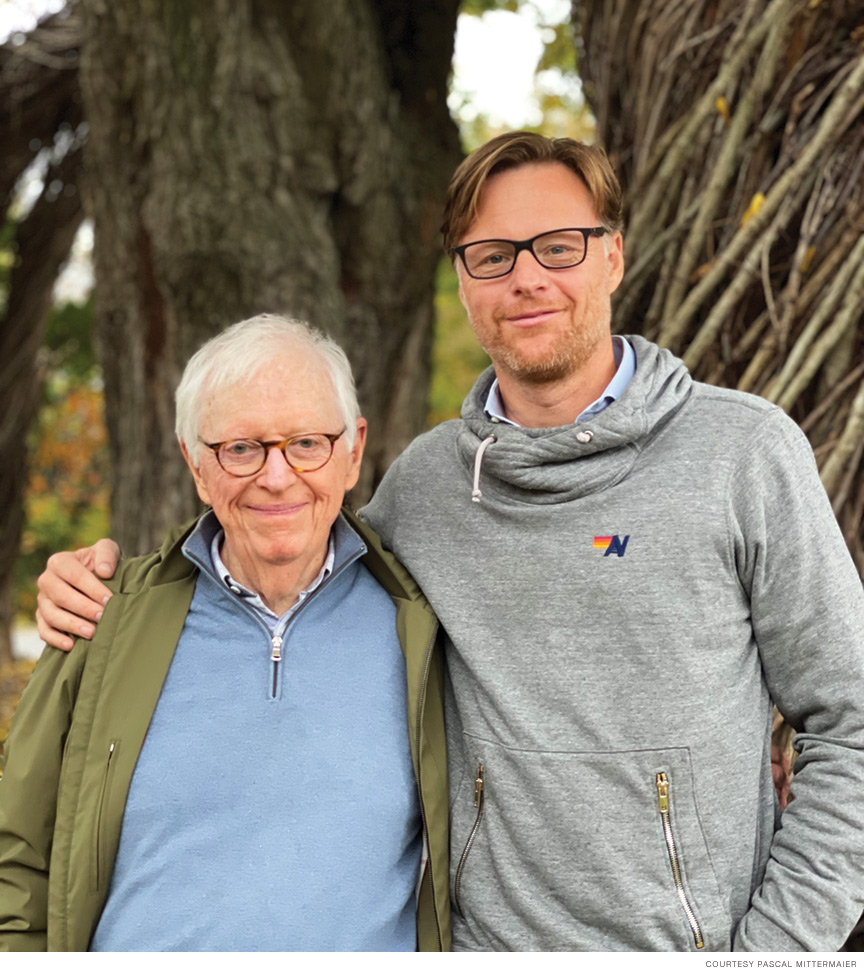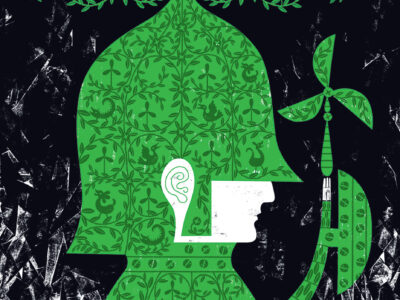
Nature Sacred has been bringing green spaces to urban areas for 25 years to improve peoples’ well-being. The mission will expand to honor the late founder’s legacy.
Editor’s note: Tom Stoner spoke with the Gazette for this piece about a month before his death on October 19. A tribute can be found at naturesacred.org/tomstoner and his obituary at the back of this issue.
Growing up in rural Iowa, Tom Stoner C’56 always felt close to nature—a deep connection he longed to renew whenever he was unable to spend time outdoors.
Satisfying his need for green spaces led to an epiphany for Stoner and his wife, Kitty. While in London on one of Stoner’s business trips in the mid-1990s, the couple arrived at their hotel, tired from their overnight flight and hoping to find a quiet place to wait for their room to be ready. “So I walked up to the front desk and asked, ‘Is there some place where we could get outside?’” Stoner said.
The concierge directed them to a small park across the street, the historic Mount Street Gardens, an urban oasis of trees and pathways dotted with benches—with an unobtrusive entrance few people might notice unless they were looking for it. As the Stoners took in the park, they saw the benches had plaques inscribed with peoples’ names and notes of appreciation for the space. Stoner later discovered that Londoners had visited the park looking for peaceful moments of respite during the Blitz in World War II as German bombs fell on the city.
Perhaps similar sanctuary, Stoner thought, could be cultivated for city dwellers in the United States who had little access to nature.
After that trip to London, the Stoners launched a nonprofit organization in 1996 to create green areas they call “Sacred Places” in urban locales, particularly in spots where people experience significant stress, such as prisons, hospitals, schools, and underserved neighborhoods. Research shows that people with regular opportunities to enjoy nature, even just a small pocket of greenery, tend to be less depressed, stressed, and anxious.
The TKF Foundation, renamed Nature Sacred in 2020, has overseen the creation of more than 100 “Sacred Places” around the country. Pascal Mittermaier C’89 joined the board of Nature Sacred in 2019 and became its chair in October 2022. Mittermaier is committed to expanding Nature Sacred’s work spreading the restorative power of nature.
The Stoners first met Mittermaier when he was the global managing director for cities at the Nature Conservancy, an international environmental nonprofit group. Mittermaier’s two decades in life sciences and healthcare made him a good fit to help the couple promote the link between exposure to nature and well-being. “When you green up a neighborhood, good stuff happens,” Mittermaier said. “People go outside more and they’re more interested in growing their own food and preserving the nature that’s there. There are no downsides to it.”
Thanks to a gift from the Stoners, the University became the site of an early Sacred Space: the Stoner Courtyard at the Penn Museum. Once a parking lot, the public courtyard built in 1998 now features a marble fountain, paths, and lawn flanked by a variety of large trees and shrubs—offering students, staff, and museum visitors a green place to sit and reflect.
Other Sacred Places include the Butterfly Garden and Overlook in Joplin, Missouri, designed to aid community resilience and support recovery in the wake of the 2011 tornado that devastated the town. The Maryland Correctional Institution in Jessup, Maryland, has a meditative garden with a mini arboretum of saplings tended by inmates. The Green Road Project at Walter Reed National Military Medical Center in Bethesda, Maryland, brings the healing power of nature to injured veterans and their families.
In launching the organization, Stoner drew on his experiences as a successful entrepreneur and a nature lover. Among other ventures, he cofounded Stoner Broadcasting, a national radio company that CBS acquired in 1998, and American Tower, which became the world’s largest network of cell phone towers; served as the founding director of the Conflict Resolution Clinic associated with George Mason University; and was chairman of the Chesapeake Bay Foundation in Annapolis, Maryland (where he lived).
His work with the Chesapeake Bay Foundation spurred a realization that became central to Nature Sacred’s mission. The real threat to the ecosystem is humans’ increasing disconnection with nature; research indicates roughly 80 percent of the US population lives in urban areas. Every Sacred Place, whether it’s a small community garden or an expansive park, adheres to several principles to achieve the greatest impact. It must be open and accessible to all; designed to encourage peace and mindful reflection; located within the community it serves; and directed by that community. Community engagement, input, and consensus is vital to the development of a Sacred Space. “That’s the number one challenge—make sure you’re listening to the communities,” Stoner said.
All Sacred Places have a “Firesoul,” the Stoners’ term for the lead caretaker of each space. (The TKF Foundation stands for Tom+Kitty+Firesouls.) Firesouls lead the way in maintaining the Sacred Place, coordinating events held in the space and understanding community concerns and needs. Stoner recalled one Firesoul who had a very particular vision for the small Sacred Place proposed in his west Baltimore neighborhood, where he had lived for 40 years. The Kirby Lane Park would be a gathering place for residents, with a serenity garden, a playground—and an area devoted to playing horseshoes, which was much of the neighborhood’s favorite pastime. “If you tried to take [the horseshoe pit] out of there today there would be a revolution,” Stoner said.
Individuals who visit Sacred Places are encouraged to write down their feelings inside yellow journals at each site. Adults and children have left messages that range from the profound—“In a world dominated by the rigid scientific mechanical cause and effect model, this place reminds us that we and the world have a soul”—to simpler expressions of appreciation—“It’s beautiful outside (stop and look).”
Nature Sacred compiled the most memorable entries in a book called BenchTalk: Wisdoms Inspired in Nature. A paperback version of the book was released in October, with all proceeds funding Nature Sacred’s work.
Mittermaier, a native of Germany who lives in Boston with his wife Su-Yin Mittermaier C’90, is focused on several goals for the future. With CEO Alden Stoner, the Stoners’ daughter, Mittermaier plans to double the number of Sacred Places across the US in the next three years and scale the organization accordingly. “We are riding a tidal wave of interest and demand,” he said. “There is so much interest that it’s really up to us to figure out how to harness that.” Much of the demand, he added, stems from the raised awareness of nature, health, and social justice issues that occurred during the pandemic.
Nature Sacred will continue working with researchers, including Eugenia “Gina” South Gr’12—associate professor of emergency medicine at the Perelman School of Medicine and the recently named inaugural director of the Penn Medicine Center for Health Justice—to study the impact of green spaces on individuals and communities [“Gazetteer,” Nov|Dec 2020].
Mittermaier will also lead fundraising efforts to make Nature Sacred self-sustaining. The organization has obtained grants and local government support, but the Stoners’ personal philanthropy funded much of its projects in the past.
More than anything, Mittermaier wants to preserve and honor the legacy of Stoner, who he’ll “miss dearly as a friend and mentor,” he said. “His passing makes all of us at Nature Sacred more determined than ever to continue his legacy.”
Before Stoner died in October, he had already stepped back from running Nature Sacred, calling it “amazing” to watch others take the lead. He also noted that while he thoroughly enjoyed his 35-year career in business, he loved building Nature Sacred even more. “I learned about the human condition, about human beings, and that has been really enlightening,” Stoner said. “So it has been pure joy for me to do it.”
—Samantha Drake CGS’06




